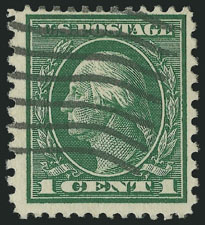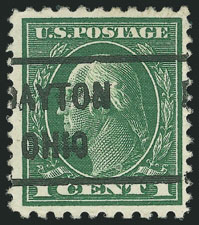
Washington Head
1¢ Stamps with Compound or Unusual Perforations
Unusual or Compound Perforations on the 1¢ Stamp

Flat Plate - Perf 12x10 Siegel 877*

Flat Plate - Perf 10x12 Siegel 877*

Offset - Perf 12.5 x 12.5 Number 536 - Rosback Perfs

Rotary - Perf 11 x 10 Number 538

Rotary - Perf 10 x 11 Number 542
| Perforation | Method of Printing | Watermark | Number | Size of Frame | Fakes can be made from |
| Perf 12 X 10 | Flat Plate | single-line | 423A | 19 x 22 mm | 408, 424 |
| Perf 10 X 12 | Flat Plate | single-line | 423D | 19 x 22 mm | 408, 424 |
| Perf 12.5 | Offset | none | 536 | 19 x 22 mm | 531 |
| Perf 11 X 10 | Rotary Press | none | 538 | 19.5-20 x 22 mm (wider) | 490 |
| Perf 10 X 11 | Rotary Press | none | 542 | 19 x 22.5 mm (taller) | 486 |
Washington-Franklin Identifier
Caution!
The 2¢ perf 12x10 and 10x12 stamps are candidates for fakery, since they are relatively easy to manufacture from the imperforate Number 409 and less so by reperforating two sides of a Number 424. However, they are so rare that a fake would hardly escape detection.
*The stamps illustrated are courtesy of the Robert A. Siegel Auciton Galleries, Inc. and are from sale #877, "The Chesapeake Collection of U.S. 1914 Compound Perforations," June 12, 2004. This is the finest study of the 1914 compound perforations to date. Siegel includes an illustrated census of each variety as well.
Number 536 is a possible candidate for fakery if the centering is superb. It is unusual to find well-centered copies of this stamp and they bring a huge premium over F-VF stamps. There is therefore some incentive to add perforations to the imperforate offset stamp, Number 531. Normally centered examples of 536 should not present a problem, since there is little incentive to produce a poorly centered copy from the imperforate stock.
Number 538 and Number 542 are not a real problem, since adding perforations (perf 11) to the top and bottom of the coil stamp Number 490 or to the left and right sides of Number 486 results in a stamp that is a little short. There is no rotary press imperforate stock from which to make either stamp, meaning the stamp can only be faked by adding perforations to a coil stamp. Certifying either stamp is optional, although as always we recommend purchasing the stamp from a reputable seller.





